Table of Contents
Jaguar Cichlid: A Quick Summary
Jaguar cichlids are large, predatory fish native to Central America. They are known for their striking patterns and bright colors, which can range from green to blue to orange. In the wild, they are opportunistic predators that feed on a variety of prey, including smaller fish, crustaceans, and insects. In captivity, they should be fed a diet consisting of high-quality cichlid pellets and frozen or live protein sources.
Jaguar Cichlid Overview
Hobbyists with an affinity for larger tank fish may find the jaguar Cichlid a lovely tank pet. One fact worth noting, though, is that it does better for the advanced fish keepers. Newcomers may find it a little cumbersome as it is pretty aggressive and has quite several needs. All the same, a hobbyist willing to take the jaguar challenge is welcome on board.
Also known as Parachromis Managuensis, the jaguar cichlid is no doubt a remarkable fish. With its elegantly dotted body and lovely shape, it can make for a beautiful tank companion.
| Information Chart | Jaguar Cichlid |
| Scientific Name: | Parachromis Managuensis |
| Family: | Cichlid |
| Care Level: | Easy |
| Temperament: | Aggressive, predator fish |
| Color: | Gold-silver, and black |
| Lifespan: | 10 years or more |
| Size: | Around 21 inches or 55 cm |
| Diet: | Carnivore |
| Minimum Tank Size: | 100 gallons or more |
| Temperature: | 73 to 82 degrees F |
| Water
Conditions: |
pH 7 to 8, Water Hardness 15 to 25 dGH |
| Tank Mate Compatibility | Only other Jaguar Cichlid |
Jaguar Cichlid Appearance
The Jaguar has an elongated body that is oval-shaped. In the wild, it can grow to be as long as 60cm with approximately 3.5 pounds. In captivity, however, it grows to about 40cm with less weight.
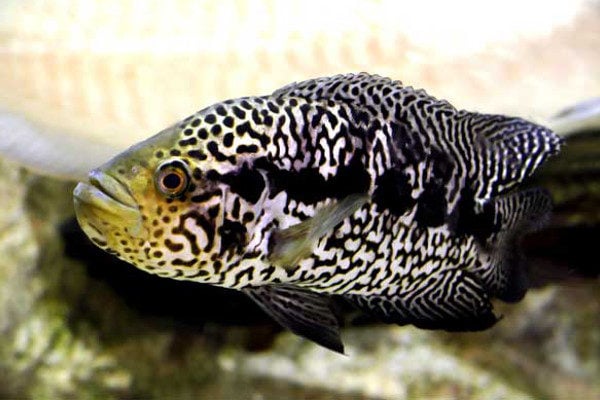
Juvenile jaguar cichlids, both males and females, have black bands on their profiles. The bars extend throughout their backs to finally stop somewhere near the lateral line. As they mature, these markings tend to diminish, leaving behind spots instead. It is from these spots that the fish obtained the jaguar name because it resembles one.
Two dark bars dot the back of their eyes. The first one is horizontal, with a broken extension towards the first bar (which is vertical)—the second run down diagonally, extending towards the gill cover. As they mature, the males shed off this bar to develop a jaguar-like pattern on their bodies. The bands are evenly distributed. Females, on the other hand, maintain this bar, with some losing it altogether. Those that lose it obtain black dots across their bodies.
Most jaguar cichlids are anywhere from silvery to light purple. A good number are in between light blue and light green. On the head is a light tan of yellow and burgundy red. For an exciting color experience with the fish, ensure the water is clean. Clearer water seems to help its color radiate in light.
The lifespan of a Jaguar Cichlid
The typical lifespan of a Jaguar Cichlid is around 10 years. If well taken care of, the jaguar cichlid can live up to 15 years.
Jaguar Cichlid Size
The typical Jaguar Cichlid typically grows up to 14 inches on the lower end and 16 inches for larger specimens. Like most cichlids, even Jaguar Cichlids are known for their vast size. Usually, female Jaguars are smaller than males. In the wild, some of these even grow up to 2 feet!
Natural Habitat and Origin
The Jaguar cichlid was noticed for the first time in 1867 by Gunther. It is most popularly known to inhabit Central American lakes, rivers, and basins. It is widely found in Nicaragua’s Managua Lake, River Ulua in Honduras, and the Matina River found in Costa Rica.
Due to marine exports and imports, the fish is in various countries, including the US, Mexico, Singapore, Guatemala, Salvador, and Panama. In most of these water bodies, there is considerable damage to flora and other marine animals. It is an aggressive fish that is also gluttonous.
Jaguar Cichlid Care & Tank Set-Up
If you wish to keep these varieties of Cichlids in your home aquarium, you will have to bear in mind certain things. Below is an essential guide that you can follow to rear the fish in your home aquarium:
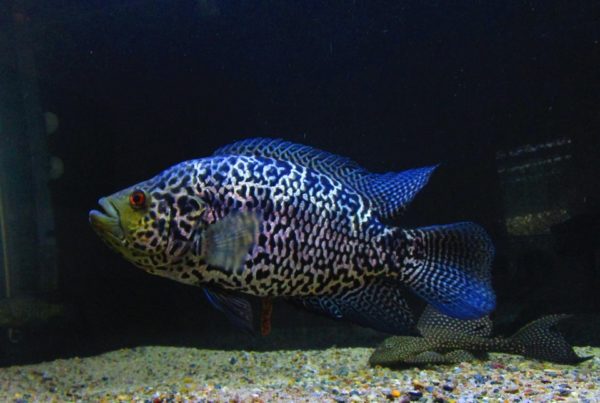
Owing to its vast size, the fish deserves a big tank. A tank size of 100 gallons or more should be sufficient. Other tank requirements are as follows.
Jaguar Cichlid Tank Size and Specifications
Optimum Tank Size for Jaguar Cichlid
The recommended tank size for Jaguar Cichlids is at least 100 gallons or 132.1 x 78.7 x 63.5 cms. If your plan involves only one adult Jaguar Cichlid, then you will need a 70-gallon tank. As these fish grow quite big, they will need enough space to maneuver around the tank and explore. The idea Jaguar Cichlid tank size should be between 100 to 125 gallons. With every pair you add to the tank, increase the size by 100 gallons. Keep in mind that Jaguar Cichlids will act aggressively even towards their species, so having enough space is important.
Tank Shape for Jaguar Cichlid
Any tank shape is okay for Jaguar Cichlids as long as it allows them to move freely. Do not go in for narrow rectangular tanks, though, as they might get restrictive. When you choose a tank for them, keep in mind that it must have a tank lid. Ensure the aquarium lid is tightly closed since it jumps high.
Filter Type
To keep the tank clean and your fish in perfect condition, you will need to invest in a powerful filter such as a sump-style one or a canister filter.
Substrate
For a Jaguar Cichlid tank, use enough substrate as they eagerly dig into it. As they are bottom-dwellers, they will spend most of their time near the substrate. You can pour a thick layer of sand for them to play in. You can use dark gravel, such as ADA AquaSoil, to help highlight the lovely colors of the fish. But, keep in mind not to use rough rocks that might scrape them and cause infections. Also, avoid rocks of the size that they can fit into their mouth. You don’t want them eating your substrate along with food particles.
How many Jaguar Cichlids can live in a 70-gallon tank?
As mentioned previously, a 70-gallon tank is a starter option for adult Jaguar Cichlids. If you have a 70 or smaller gallon tank size, you can only house one adult Jaguar Cichlid. For a juvenile, even a 30-gallon tank will do fine.
Water Parameters for Jaguar Cichlid
Jaguar Cichlids are sensitive to water temperatures and pH, so you must make sure to maintain the required amount at all times. Changing one-third or two-thirds of the water weekly is a compulsion for a Jaguar Cichlid tank.
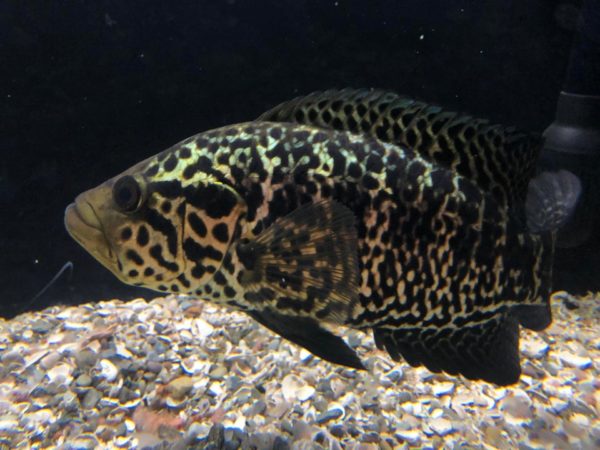
Water Temperature
The ideal water temperature for Jaguar Cichlids is 70 to 80 degrees F. When you change the tank water, ensure that the new water has the same temperature as the old one. Jaguar Cichlids are very sensitive to temperature changes. Try and keep the temperatures between 24 and 30 degrees centigrade. Although studies indicate that it can withstand a little drop in temperature, maintaining the desired temperature helps keep it toasty. High temperatures also make it aggressive towards other fish species if the tank is shared.
Water Flow Rate
The water flow rate that Jaguar Cichlids like is a fast flow. You can get a fast water flow rate easily by installing a pump in the tank.
pH Level
The perfect water pH level for Jaguar Cichlids is 7 to 8. The streams and slow waters that these fish have a neutral to slightly acidic pH.
Water Hardness
The water hardness for a Jaguar Cichlid tank can range anywhere between 15 to 25 dKH.
Jaguar Cichlid Tank Landscape
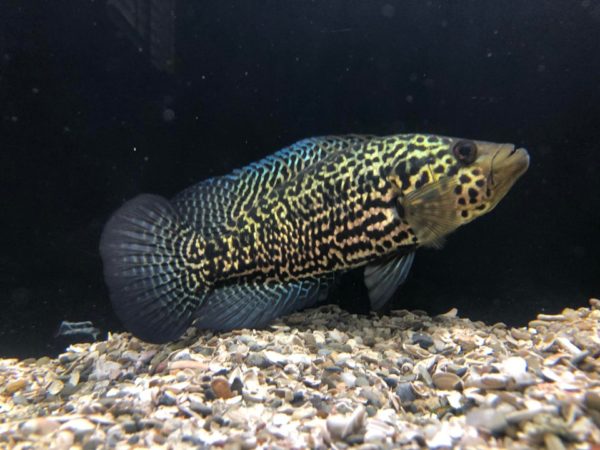
The best way to make a fish feel at home is to set up a tank that mimics their natural environment. For fish species such as the Jaguar Cichlids use a lot of natural decorations to set up the tank.
Best Plants for Jaguar Cichlid Tanks
Jaguar Cichlids are plant terrors despite living in murky water filled with plants and debris. Provide floating plants in their tank as they are bottom dwellers that may not allow rooted plants to stand firm. If you still want to include potted plants, then make sure the plants are protected with rocks and driftwood around the stem to prevent them from being uprooted. Some great floating plants are Java Moss, Water Wisteria, Hornwort, Anacharis, Duckweed, Brazilian Pennywort, etc.
Worst Plants for Jaguar Cichlid Tanks
Plants that are thin and rooted are a big no-no for a Jaguar Cichlid tank. The fish will take no time to uproot these and make a mess of your aquarium.
Decorations for Jaguar Cichlid Tanks
Mixing these plants with other items for decor such as driftwood, leaf litter, or pieces of rock, is an excellent addition to any tank. Adding things like a small plant or a colorful stone keeps the fish engaged, as they love playing hide and seek around these massive structures. They will also have multiple hiding places, which will replicate their natural environment.
Lighting for Jaguar Cichlid Tanks
There is no need for extra lighting for a Jaguar Cichlid tank. The fish are used to hiding under cover of rocks and living in murky water. However, the live plants in the tank will need light to grow. For this, the natural lighting hitting the tank is enough. Provide sufficient filtration so that its water remains clean. Its radiance is more noticeable when the water is clear.
Feeding Jaguar Cichlid
Best Diet for Jaguar Cichlid
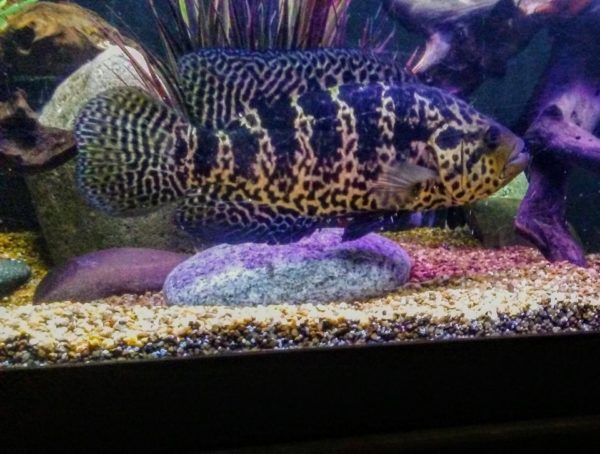
It is a wide feeder that enjoys eating flesh. If housed with smaller-sized fish, the jaguar can easily make a meal out of them. When not well fed too, it becomes quite aggressive. You should therefore observe its meal times to avoid unlikely situations:
- Small feeder fishes like the swordfish
- Frozen and dried foods
- Fish pellets
- Cut up fish like crayfish
- Tadpoles
- Bloodworms
- Earthworms
- Crickets
While feeding it flesh, ensure some vitamins are added to help boost its overall health. Avoid giving them beef or poultry feeds as these may harm them. Remember, their systems are not accustomed to some of these feeds, and avoiding them will help keep the pet healthy.
How often should you feed Jaguar Cichlids?
The Jaguar should typically be fed once a day. If possible, let it starve one day each week or fortnightly to help strengthen its resolve. This helps when one may be away for longer than expected.
Jaguar Cichlid Behaviour and Temperament
Jaguar Cichlids are aggressive, territorial, and are an expert at picking fights. Owing to their behavior, they will not only pick fights but these fights will usually end in the death of either of the fish. Apart from that, you will find them swimming at the bottom and spending most of their time digging around in the sand and trying to find bits of food.
Is the Jaguar Cichlid lone or societal?
Juvenile Jaguar Cichlids are more societal than adults. As they grow up, they will become more and more aggressive. They aren’t the most social fish out there and don’t do well in community tanks. They can only be housed with other Cichlids, as detailed below.
Jaguar Cichlid Tank Mates
Ideal Jaguar Cichlid Tank Mates
The Jaguar Cichlid is rather aggressive and best kept with its size fish. If stocked with smaller fish, it can make a meal of them.
When they have to be kept with other types of fish their size or bigger, a bigger tank is necessary. More caves and hiding places are also required. This helps the other tankmates when the male becomes aggressive towards them. Some good tank mates for a Jaguar Cichlid tank are:
- Oscar fish
- Convict Cichlid
- Flowerhorn Cichlid
- Green Terror Cichlid
- Pinnatus Batfish
- Red Devil Cichlid
Bad Tank Mates for Jaguar Cichlid
Any and every small or peaceful fish is a bad choice for a Jaguar Cichlid tank. They will hunt the fish and eat them. Any fish with a smaller body size will immediately die with Jaguar Cichlids, so only keep these with other Cichlid species.
Breeding Jaguar Cichlid
If Jaguar Cichlids are kept in a community tank, it is best to separate them during spawning. For successful breeding, the following tank conditions are necessary:
- A 300 liters tank capacity is mandatory. The huge tank is required as the male seems to be very aggressive towards its species.
- Enough rocks with caves and substrate where the female may hide if the male begins to oppress it.
- Plenty of dried and floating plants where the female lives help in the egg-laying.
- Water temperatures are to be increased slightly by about 4-6 degrees.
- Proper feeding to help reduce the male’s aggression.
The male begins to display some fondness towards the female, which may last longer or shorter depending on various factors. The female lays eggs on a flat stone or large snag. It can lay about 5,000 eggs or more. The eggs appear transparently yellow.
The pair can be transferred back to their tank once this process is complete to not feed on their fry.
After about two to three days, the eggs hatch, and the fry will appear. For the first few days, they feed on the yolk sac. After they begin to swim, you can feed them crushed grains and tubifex.
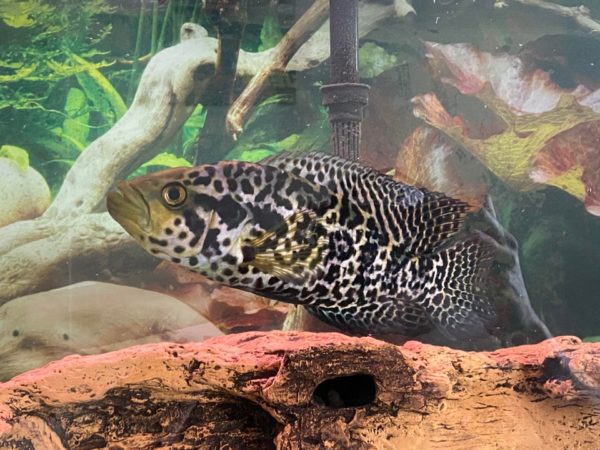
The juveniles often grow differently. Some grow big faster than the rest. They can be separated according to their sizes so that the bigger ones do not feed on their smaller counterparts.
Jaguar Cichlid Breeding Level – Easy
Jaguar Cichlid Sexual Dimorphism?
To distinguish between male and female Jaguar Cichlid, we must observe the body size and the types of marking on their body. Females are usually smaller than males in size. Males also have more vertical marks on their body which dissolve when they grow up. In the case of females, the effects are thinner.
Jaguar Cichlid Common Diseases and their Treatment
Jaguar Cichlids are not at risk of any major diseases. But being freshwater fish, they can suffer some common issues, which you can treat if spotted on time.
Ich
The symptoms include lethargy, loss of appetite, and restless behavior, but most importantly, white spots on the fish’s body. This illness will go away once you meet the ideal water conditions.
Parasitic infections
These are common in unclean water. If any leftover debris is in the tank, it will cause bacteria that contribute to these infections. The best thing to do is to isolate the affected fish and treat them first. If you maintain hygiene and care in the tank, these diseases will not occur.
Apart from looking out for these common diseases, stress reduction, offering plentiful space to them, and providing a clean tank are the best things that you can do to care for your Jaguar Cichlids.
Facts about Jaguar Cichlid
- Jaguar Cichlids are native to Central America, especially in the Ulua River and Matina River in Costa Rica.
- Jaguar Cichlids have many other common names such as Managuense Cichlid, Jaguar Guapote, Managua Cichlid, Aztec Cichlid Guapote Tigre, Spotted Guapote, and Tiger Guapote.
- They like murky water and like to live in warm temperatures.
- It had two scientific names before Parachromis Managuensis, namely Nandopsis Managuense and Cichlasoma Managuense.
- They prefer living in pairs and are not societal beings.
Is Jaguar Cichlid Right For You?
Author’s note: Jaguar Cichlids can sometimes challenge aquarists, but caring for them is very rewarding. Not only are they stunning to look at, but they are also fun to study. They are easy to breed as well. By keeping Jaguar Cichlids, an aquarist can learn how to make informed decisions on fish care. But, if you are new to this hobby and do not want to overwhelm yourself, then we recommend staying away from Jaguar Cichlids for now.
FAQs
Why will my Jaguar Cichlid not eat live food?
Jaguar Cichlids love eating live food, so if yours is not eating, the reason could be something else. Most of the time, they won’t eat food until they feel safe. Try waiting for a couple of days, or take a professional’s help to determine the cause.
Where is the Jaguar Cichlid native too?
Jaguar Cichlids are native to Central America. You can find them in small ponds, lakes, or streams. Some water bodies where they are popular are Managua Lake, River Ulua, and River Matina.
How long does it take Jaguar Cichlid eggs to hatch?
During the breeding process, the female will lay around 2000 eggs. Most eggs will hatch within a week. The fry will take one week, though, before they can swim on their own.
Where to buy Jaguar Cichlid?
You can buy Jaguar Cichlids from any local fish store. If you are purchasing them online, verify that you are picking healthy Jaguars. A tip to keep in mind is that juvenile Jaguars are much cheaper than adult ones. The main reason for this is that as they grow up, their colors look more attractive and their price goes up.
Why is my Jaguar Cichlid hiding?
If you notice that your Jaguar has been hiding for a long time, then recheck the entire tank set-u once. Make sure that the temperature and water flow are perfect, and use a testing kit to determine the levels of ammonia and nitrate in the tank. Fish usually hide when they are stressed or uncomfortable. And the reason could be the change in water temperature or some underlying cause. If you cannot get the fish to come out, then seek the help of a licensed professional as soon as you can.
Are Jaguar Cichlids aggressive?
Yes, Jaguar Cichlids are aggressive. They can be pretty territorial as well. So, you need to ensure that your Jaguar has enough space in the tank. They pick fights with other fish around them and will eat smaller fish or any invertebrate in the tank.
Conclusion
Now that we know everything there is to know about Jaguar Cichlids, it is time for you to decide whether it is the right fish for you. As we have already seen, Jaguar Cichlids are indeed fantastic fish. Rearing fish often requires care, but it turns out to be a rewarding practice. Jaguar Cichlids do require more effort than the average fish, so if you are a beginner, then proceed with caution. While the Jaguar Cichlid is a lovely tank animal, it is best kept by experienced hobbyists as its needs may elude first-timers.
No related posts.
